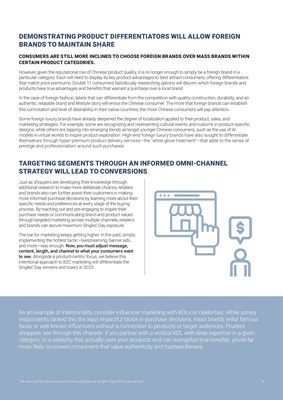
CONSUMERS ARE STILL MORE INCLINED TO CHOOSE FOREIGN BRANDS OVER MASS BRANDS WITHIN
CERTAIN PRODUCT CATEGORIES.
However, given the reputational rise of Chinese product quality, it is no longer enough to simply be a foreign brand in a
particular category. Each will need to display its key product advantages to best attract consumers, offering differentiators
that match price premiums. Double 11 consumers fastidiously researching options will discern which foreign brands and
products have true advantages and benefits that warrant a purchase over a local brand.
In the case of foreign fashion, labels that can differentiate from the competition with quality construction, durability, and an
authentic, relatable brand and lifestyle story will entice the Chinese consumer. The more that foreign brands can establish
this connotation and level of desirability in their native countries, the more Chinese consumers will pay attention.
Some foreign luxury brands have already deepened the degree of localization applied to their product, sales, and
marketing strategies. For example, some are recognizing and representing cultural events and customs in product-specific
designs, while others are tapping into emerging trends amongst younger Chinese consumers, such as the use of AI
models in virtual worlds to inspire product exploration. High-end foreign luxury brands have also sought to differentiate
themselves through hyper-premium product delivery services-the "white glove treatment"-that adds to the sense of
prestige and professionalism around such purchases.
Just as shoppers are developing their knowledge through
additional research to make more deliberate choices, retailers
and brands also can further assist their customers in making
more informed purchase decisions by learning more about their
specific needs and preferences at every stage of the buying
process. By reaching out and pre-engaging to inspire their
purchase needs or communicating brand and product values
through targeted marketing across multiple channels, retailers
and brands can secure maximum Singles' Day exposure.
The bar for marketing keeps getting higher. In the past, simply
implementing the hottest tactic-livestreaming, banner ads,
and more-was enough. Now, you must adjust message,
content, length, and channel to what your consumers want
to see. Alongside a product-centric focus, we believe this
intentional approach to B2C marketing will differentiate the
Singles' Day winners and losers in 2023.
DEMONSTRATING PRODUCT DIFFERENTIATORS WILL ALLOW FOREIGN
BRANDS TO MAINTAIN SHARE
TARGETING SEGMENTS THROUGH AN INFORMED OMNI-CHANNEL
STRATEGY WILL LEAD TO CONVERSIONS
As an example of intentionality, consider influencer marketing with KOLs or celebrities. While survey
respondents ranked this the least impactful factor in purchase decisions, most brands enlist famous
faces or well-known influencers without a connection to products or target audiences. Prudent
shoppers see through this charade. If you partner with a vertical KOL with deep expertise in a given
category, or a celebrity that actually uses your products and can evangelize true benefits, you're far
more likely to convert consumers that value authenticity and trustworthiness.
9
The new normal: Silver economy shines brightly as Singles' Day 2023 approaches